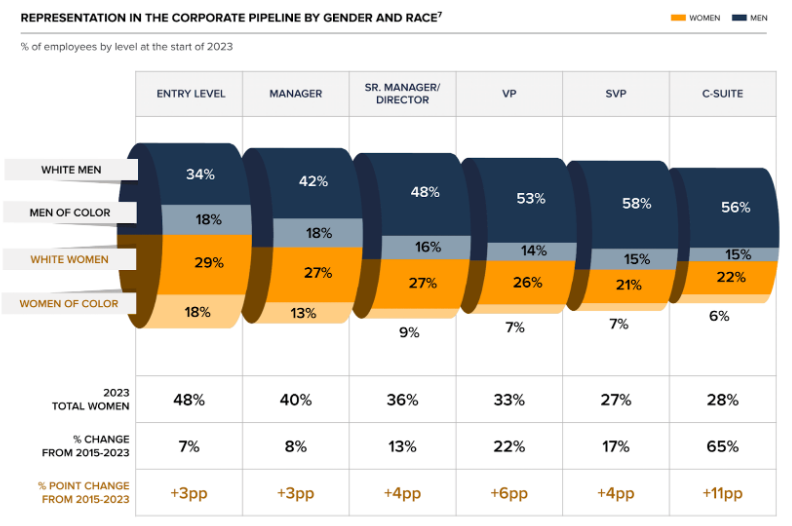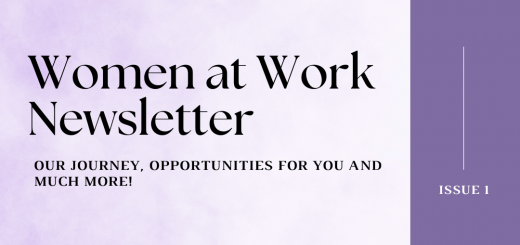Women in the Workplace 2023
Source – McKinsey & Company, LeanIn.Org
McKinsey & Company in partnership with LeanIn.Org, have launched a report ‘Women in Workplace 2023‘. This is the most extensive study to date focusing on women in corporate America and Canada. With data collected from 276 participating organizations employing over ten million individuals, the report delves into the experiences of more than 27,000 employees and 270 senior HR leaders, shedding light on their policies and practices. Significantly, this report adopts an intersectional approach to examine the distinct challenges and obstacles faced by Asian, Black, Latina, and LGBTQ+ women, as well as women with disabilities within the workforce.
This research shows notable progress in achieving higher representation of women in top executive positions, reaching an all-time high in the C-suite. Nonetheless, there’s still a significant lack of advancement in the mid-level career stages, and the ongoing underrepresentation of women of color makes true gender parity a distant goal.
The survey challenges four common myths about women’s workplace experiences and career progress. While some of these myths have been discussed before, the lack of substantial progress makes it necessary to reiterate them. These myths encompass women’s career aspirations, the primary hindrance to their advancement to senior leadership, the impact and prevalence of workplace microaggressions, and women’s interest in flexible work arrangements.
State of the Pipeline
Women, particularly women of color, still grapple with underrepresentation throughout corporate hierarchies. While there’s progress in women’s presence in senior leadership, notably in the C-suite (increasing from 17% to 28% since 2015), these gains are precarious. The manager and director levels experience slower advancement, affecting most women in corporate America. Alarmingly, women at the director level are departing at a higher rate than in previous years and more than men at that level, reducing the pool of women eligible for top positions.
Key Highlights:
- Approximately one in four C-suite leaders is a woman, while women of color comprise just one in sixteen.
- The most significant decline in representation, occurring from the entry-level to the C-suite, is experienced by women of color. Their representation diminishes by two-thirds as they progress through the career pipeline.

The Myths and the Reality
Myths – Women are Becoming less Ambitious.
Reality – Women are more ambitious than before the pandemic – and flexibility is fueling that ambition.
Despite recent reports suggesting waning ambition among women, our data paints a different picture. Women’s commitment to their careers and desire for advancement matches that of men at every career stage, including those working remotely. Notably, 90% of women under 30 aspire to the next career level, with 75% aiming for senior leadership roles. Women of color are even more ambitious, with 96% valuing their careers and 88% seeking promotion to the next level.
Myth: The biggest barrier to women’s advancement is the ‘glass ceiling’
Reality: The ‘broken rung’ is the greatest obstacle women face on the path to senior leadership
Women have encountered the most significant hurdle at the initial step to manager positions, with just 87 women promoted for every 100 men transitioning from entry-level. This problem is even more pronounced for women of color, with only 73 women of color promoted to manager for every 100 men this year, down from 82 the previous year. This “broken rung” leaves fewer women available for director positions, and progress remains challenging for early-career Black women, with only 54 Black women promoted for every 100 men from entry level to manager positions this year.
Myth: Microaggressions have a ‘micro’ impact
Reality: Microaggressions have a large and lasting impact on women
Years of data highlight that women face a significantly higher rate of microaggressions, being twice as likely to experience interruptions and comments about their emotional state. This issue is more pronounced for women with traditionally marginalized identities. Asian women are 7 times more likely to be racially misidentified, Black women are 3 times more likely to code-switch, LGBTQ+ women are 5 times more likely to hide personal aspects, and women with disabilities feel pressured to perform perfectly. Women enduring microaggressions are 4 times more likely to feel consistently burned out and 3 times more likely to contemplate leaving their companies.
Myth: It’s mostly women who want—and benefit from—flexible work
Reality: Men and women see flexibility as a ‘top 3’ employee benefit and critical to their company’s success
Workplace flexibility is now vital for both women and men, providing efficiency, work/life balance, and reduced fatigue. On-site work benefits men more, with only 39% of men and 34% of women feeling connected to their organization’s culture. Remote work reduces microaggressions and fosters psychological safety for women. It also decreases unpleasant interactions with coworkers for 29% of women and 25% of men. Additionally, 53% of women and 36% of men believe that offering significant flexibility in work hours and locations is crucial for their company’s future success.
Recommendations for companies
As companies work to support and advance women, they should focus on five core areas:
- Track Outcomes for Women’s Progress: Companies should rigorously measure and analyze women’s career outcomes and experiences to identify and rectify trouble areas. This includes data on hiring, promotions, attrition, career development, performance, and employee sentiments. Transparency with diversity, equity, and inclusion (DEI) goals and metrics is crucial.
- Support and Reward Managers for Change: Managers play a pivotal role in fostering DEI and employee well-being. Clearly define their responsibilities, evaluate them on people management metrics, provide necessary skills through training, and ensure they have the time and resources to excel in these aspects.
- Combat Microaggressions: Companies must communicate a zero-tolerance policy for microaggressions and disrespectful behavior. Offer employees high-quality bias and allyship training, encourage them to challenge microaggressions, and create a culture where surfacing these issues is normal.
- Fine-tune Flexible Work Models: Establish clear expectations for flexible work arrangements, measure their impact, and ensure a level playing field across work arrangements. Evaluate outcomes across different work models to prevent bias and penalization.
- Fix the Broken Rung for Women, Especially Women of Color: Companies should track promotions by race and gender, de-bias performance reviews and promotions, and invest in career advancement programs tailored to women of color’s unique challenges. Track outcomes with an intersectional lens to address inequities.
In addressing the comprehensive challenges outlined, it’s evident that achieving gender equity and fostering inclusion in the workplace is a complex undertaking. From tracking outcomes to supporting managers, tackling microaggressions, optimizing flexible work models, and addressing the broken rung for women, especially women of color, these strategies form the foundation for building a diverse and inclusive work environment. These actions not only benefit women but also contribute to the overall success and well-being of organizations. It is high time for businesses to proactively address these challenges and create a workplace where all employees can thrive.
You can read the full report here!


